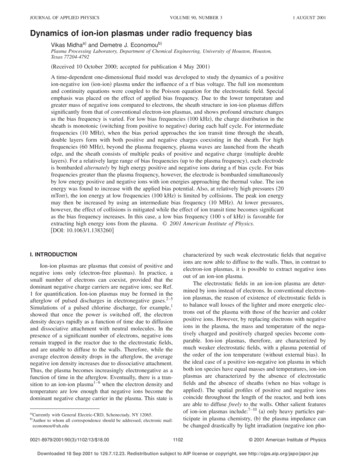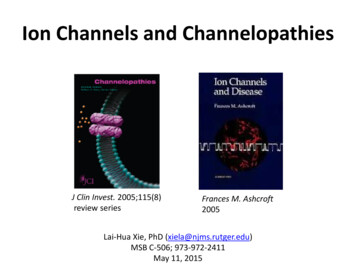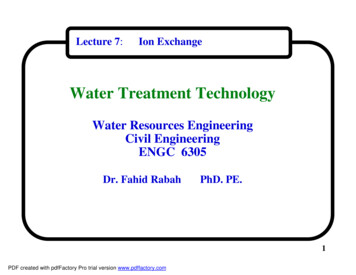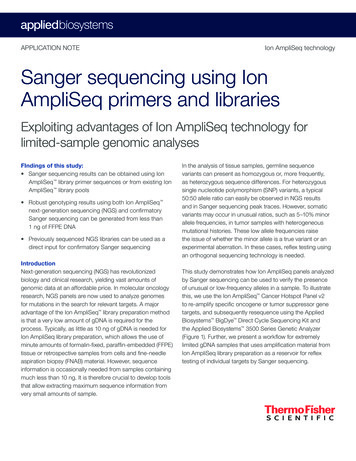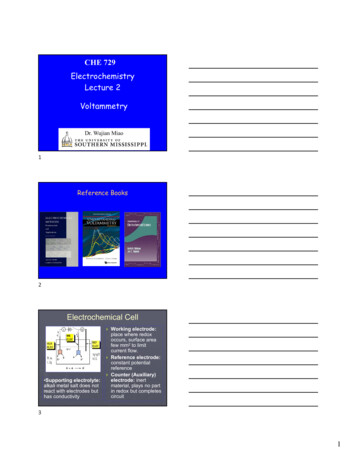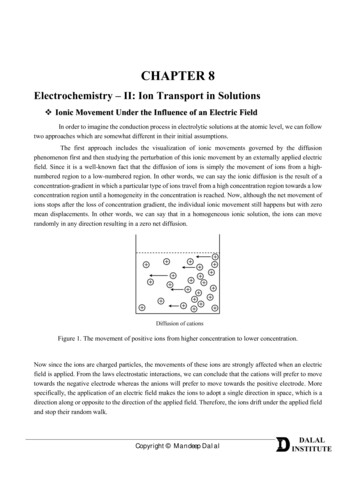
Transcription
CHAPTER 8Electrochemistry – II: Ion Transport in Solutions Ionic Movement Under the Influence of an Electric FieldIn order to imagine the conduction process in electrolytic solutions at the atomic level, we can followtwo approaches which are somewhat different in their initial assumptions.The first approach includes the visualization of ionic movements governed by the diffusionphenomenon first and then studying the perturbation of this ionic movement by an externally applied electricfield. Since it is a well-known fact that the diffusion of ions is simply the movement of ions from a highnumbered region to a low-numbered region. In other words, we can say the ionic diffusion is the result of aconcentration-gradient in which a particular type of ions travel from a high concentration region towards a lowconcentration region until a homogeneity in the concentration is reached. Now, although the net movement ofions stops after the loss of concentration gradient, the individual ionic movement still happens but with zeromean displacements. In other words, we can say that in a homogeneous ionic solution, the ions can moverandomly in any direction resulting in a zero net diffusion.Figure 1. The movement of positive ions from higher concentration to lower concentration.Now since the ions are charged particles, the movements of these ions are strongly affected when an electricfield is applied. From the laws electrostatic interactions, we can conclude that the cations will prefer to movetowards the negative electrode whereas the anions will prefer to move towards the positive electrode. Morespecifically, the application of an electric field makes the ions to adopt a single direction in space, which is adirection along or opposite to the direction of the applied field. Therefore, the ions drift under the applied fieldand stop their random walk.Copyright Mandeep Dalal
CHAPTER 8 Electrochemistry – II: Ion Transport in Solutions391The second approach to study the phenomenon of electrolytic conduction at the atomic level includesthe framing of the drift of only one ion under the externally applied field. The electric field would make theion to accelerate as per Newton’s second law. Now if the ion is in the vacuum, it would show an accelerationuntil it strikes with the respective electrode. However, it will not happen since a large number of other ionsalso present in the same electrolytic solution along with the solvent as well. Consequently, the ion is almostbound to collide with other ions or solvent particles in its journey. The ion will stop for some time and thenwill start to accelerate again. This stop-start phenomenon will impart a discontinuity in the speed and directionof this moving ion. It means that ionic movement is not very much smooth but actually a resistance is offeredby the surrounding medium. Therefore, we can say that the application of an external electric field will makethe ion move towards the oppositely charged electrode but in a stops-starts and zigzag fashion.Figure 2. The general depiction movement of ions under the influence of the external electric field.Since an ion starts moving towards the positively charged electrode only after the application of theelectric field; the initial velocity before that can simply be neglected because it arises from random collisions,which can be in any random direction. However, after applying the electric field, the ion feels a force thatmakes it move in the same direction, i.e., the direction of the electrostatic force. In other words, the electricfield will create an additional velocity component on the ion under consideration that drifts the ion to theoppositely charged electrode. Now, let 𝐹 be the force vector that imparts a drift velocity 𝑣𝑑 ; and then usingNewton’s second law of motion states that this force divided by the particle’s mass is simply equal to theacceleration. From the general expressions for acceleration, we have𝑎 𝑑𝑣𝑑𝑡AndBuy the complete book with TOC navigation,high resolution images andno watermark.Copyright Mandeep Dalal(1)
A Textbook of Physical Chemistry – Volume I392𝐹𝑚(2)𝐹 𝑑𝑣 𝑚 𝑑𝑡(3)𝑎 From equation (1) and equation (2), we haveNow although the time between two collisions may vary significantly, we can use a mean time τ for simplicitywhich can be formulated as (if N collisions take place in ‘t’ time) given below.𝜏 𝑡𝑁(4)Now because the drift velocity is imparted to the ion by the external force, its value must be equal to theproduct of meantime and the acceleration due to force, i.e.,𝑣𝑑 𝑑𝑣𝜏𝑑𝑡(5)Using the value of 𝑑𝑣/𝑑𝑡 from equation (3) in equation (5), we get𝑣𝑑 𝐹𝜏𝑚(6)It is obvious from the above relation that the meantime is related to the drift velocity showing that the jumpsbetween collisions affect ionic movement. Besides, it is also clear that the drift velocity is directly proportionalto the driving force of the applied electric field. The ionic flux can be formulated in terms of drift velocity asgiven below.𝐹𝑙𝑢𝑥 𝐼𝑜𝑛𝑖𝑐 �� 𝐷𝑟𝑖𝑓𝑡 𝑣𝑒𝑙𝑜𝑐𝑖𝑡𝑦(7)Hence, since the drift velocity is directly proportional to the electric force simulating conduction, the flux mustalso be proportional to the magnitude of the electric field, i.e.,𝐹𝑙𝑢𝑥 𝐸𝑙𝑒𝑐𝑡𝑟𝑖𝑐 𝑓𝑖𝑒𝑙𝑑(8)The nature of equation (6) also unveils the situation where the flux or the drift velocity no longer holds thedirect proportionality with the applied electric field. For equation (6), it is very important to assume that duringthe collision, the velocity component imparted to the ion by applied electric field vanishes completely and theion starts as a full-fresher each time. If this is not satisfied, these leftover velocity components would add upafter every collision and the real velocity, in that case, would be much greater than the calculation given byequation (6). In other words, equation (6) will no longer be valid. Therefore, we can conclude that for areasonable guess for drift velocity, the magnitude of the applied electric field must be very small.Buy the complete book with TOC navigation,high resolution images andno watermark.Copyright Mandeep Dalal
CHAPTER 8 Electrochemistry – II: Ion Transport in Solutions393 Mobility of IonsIt has already been discussed in the previous section that the ions in a homogeneous electrolyticsolution move randomly with zero net displacements, and the situation changes when the external electric fieldis applied. The applied field imparts a directive velocity component to the ion under consideration and makesit move towards the oppositely charged electrode. This ion collides with other ions and drifts towards theoppositely charged electrode with a stop-start and zig-zag fashion. The drift velocity (𝑣𝑑 ) of such ion is givenby the following relation.𝑣𝑑 𝜏𝐹𝑚(9)Where 𝐹 is the force exerted upon the ion by applied field and m is the mass of the ion. The symbol 𝜏 representsthe mean lifetime between to collisions during the ionic drift.It is obvious from the equation (9) that drift velocity is proportional to forces exerted by the electricfield and 𝜏/𝑚 is the constant of proportionality. The physical significance of the proportionality constant liesin the fact that it becomes equal to the drift velocity when the force is unity, and therefore, represents the“mobility nature” of the ion considered. In other words, we can say that the proportionality constant in equation(9) represents the absolute mobility (𝑢̅𝑎𝑏𝑠 ) of the ion i.e.𝑢̅𝑎𝑏𝑠 𝜏𝑣𝑑 𝑚𝐹(10)The units of absolute mobility are cm s 1 dyne 1. Now, since the functional electric force is equal to the electricforce per unit charge; or the electric field (X) multiplied with the charge on the ion (𝑧𝑖 𝑒0 ) i.e.𝐹 𝑧𝑖 𝑒0 𝑋(11)After using the value of 𝐹 from equation (11) in equation (10), we get𝑢̅𝑎𝑏𝑠 𝑣𝑑𝑧𝑖 𝑒0 𝑋𝑣𝑑 𝑢̅𝑎𝑏𝑠 𝑧𝑖 𝑒0 𝑋(12)(13)When, 𝑋 1 𝑣𝑜𝑙𝑡, the above equation takes the form(𝑣𝑑 )1volt cm 1 𝑢̅𝑎𝑏𝑠 𝑧𝑖 𝑒0 𝑢̅𝑐𝑜𝑛𝑣(14)Where 𝑢̅𝑐𝑜𝑛𝑣 represents the conventional mobility of the ion with units cm2 Volt 1 s 1. Now although theexpressions of both types of mobilities are quite similar, it is worthy to note that the “absolute mobility” has abroader domain of application because any force that governs the drift velocity can be used. On the other hand,the conventional mobility is pretty much limited to the electric force only.Copyright Mandeep Dalal
A Textbook of Physical Chemistry – Volume I394 Ionic Drift Velocity and Its Relation with Current DensityIn this section, we will try to explain how the ionic movement is quantitatively related to currentdensity flowing through an electrolytic solution under the influence of an applied electric field. To do so, weneed to understand the ionic drift velocity and then its relationship with current density. Ionic Drift VelocityWhen an ion in the electrolytic solution is placed under the externally applied electric field, theelectric field will make the ion to accelerate as per Newton’s second law. Now if the ion is in the vacuum, itwould show an acceleration until it strikes with the respective electrode. However, it will not happen since alarge number of other ions also present in the same electrolytic solution along with the solvent as well.Consequently, the ion is almost bound to collide with other ions or solvent particles in its journey. The ion willstop for some time and then will start to accelerate again. This stop-start phenomenon will impart adiscontinuity in the speed and direction of this moving ion. It means that ionic movement is not very muchsmooth but actually a resistance is offered by the surrounding medium. Therefore, we can say that theapplication of the external electric field will make the ion move towards the oppositely charged electrode butin a stops-starts and zigzag fashion. An ion starts moving towards the positively-charged electrode only afterthe application of the electric field. The initial velocity before that can simply be neglected because it arisesfrom random collisions which can be in any random direction. However, after applying the electric field, theion feels a force that makes the ion move in the same direction, i.e., the direction of the electrostatic force.Now let F be the force vector that imparts drift velocity 𝑣𝑑 , then form Newton’s second law of motion statesthat this force divided by the particle’s mass is simply equal to the acceleration.𝐹 𝑑𝑣 𝑚 𝑑𝑡(15)Now although the time between two collisions may vary significantly, we can use a mean time τ for simplicitywhich can be formulated as (if N collisions take place in ‘t’ time) given below.𝜏 𝑡𝑁(16)Now because the drift velocity is imparted to the ion by the external force, its value must be equal to productmeantime and the acceleration due to this force i.e.𝑣𝑑 𝑑𝑣𝜏𝑑𝑡(17)Using the value of 𝑑𝑣/𝑑𝑡 from equation (15) in equation (17), we get𝑣𝑑 𝐹𝜏𝑚(18)It is obvious that the drift velocity is directly proportional to the driving force of the applied electric field.Copyright Mandeep Dalal
CHAPTER 8 Electrochemistry – II: Ion Transport in Solutions395 The Relationship between Ionic Drift Velocity and Current DensityIt is obvious from the equation (18) that drift velocity is proportional to forces exerted by the electricfield and 𝜏/𝑚 is the constant of proportionality. The physical significance of the proportionality constant liesin the fact that it becomes equal to the drift velocity when the force is unity, and therefore, represents the“mobility nature” of the ion considered. In other words, we can say that the proportionality constant in equation(18) represents the absolute mobility (𝑢̅𝑎𝑏𝑠 ) of the ion, i.e.,𝑢̅𝑎𝑏𝑠 𝜏𝑣𝑑 𝑚𝐹(19)The units of absolute mobility are cm s 1 dyne 1. Now, since the functional electric force is equal to the electricforce per unit charge; or the electric field (X) multiplied with the charge on the ion (𝑧𝑖 𝑒0 ), i.e.,𝐹 𝑧𝑖 𝑒0 𝑋(20)After using the value of 𝐹 from equation (20) in equation (19), we get𝑢̅𝑎𝑏𝑠 𝑣𝑑𝑧𝑖 𝑒0 𝑋𝑣𝑑 𝑢̅𝑎𝑏𝑠 𝑧𝑖 𝑒0 𝑋(21)(22)When, 𝑋 1 𝑣𝑜𝑙𝑡, the above equation takes the form(𝑣𝑑 )1volt cm 1 𝑢̅𝑎𝑏𝑠 𝑧𝑖 𝑒0 𝑢̅𝑐𝑜𝑛𝑣(23)Where 𝑢̅𝑐𝑜𝑛𝑣 represents the conventional mobility of the ion with units cm2 Volt 1 s 1. Now although theexpressions of both types of mobilities are quite similar, it is worthy to note that the “absolute mobility” has abroader domain of application because any force that governs the drift velocity can be used. On the other hand,the conventional mobility is pretty much limited to the electric force only.Now consider a plane with unit area perpendicular to the direction of ionic movement under theinfluence of the externally applied field. Now although the cations and anions move in opposite directions,both types of ions will pass through this transit. If 𝑣 is the drift velocity of cation, then all the cations presentwithin 𝑣 cm of this transit plane will pass through it. Let 𝑗 be the cationic flux that represents the totalnumber of mole of ions passing through this area in every second. Therefore, the cationic flux must be equalto the multiplication of the corresponding volume (1 cm2 𝑣 cm) and the concentration of cations (𝑐 ) inmoles cm 3. Mathematically, we can say that𝑗 𝑐 𝑣 (24)The current density (𝐽 ) or the charge flowing through this transit plane per second due to this cationic fluxcan simply be obtained by multiplying the cationic flux by the charge carried by 1 mole of ions (𝑧 𝐹), i.e.,Buy the complete book with TOC navigation,high resolution images andno watermark.Copyright Mandeep Dalal
A Textbook of Physical Chemistry – Volume I396𝐽 𝑐 𝑣 𝑧 𝐹(25)Similarly, If 𝑣 is the drift velocity of anion and 𝑐 the concentration of anions in moles cm 3, the anioniccurrent density may simply be written as𝐽 𝑐 𝑣 𝑧 𝐹(26)Where 𝑧 is the charge number of the anion and F is Faraday constant. In general, we can write for the ithspecies as𝐽𝑖 𝑐𝑖 𝑣𝑖 𝑧𝑖 𝐹(27)Where 𝑧𝑖 and 𝑐𝑖 are the charge number and concentration in moles cm 3 of the ith type of ion.Figure 3. The general depiction ionic movement through transit plane under applied field.Hence, the total current density from all the ionic species must be the summation of their individual currentdensities, i.e.,𝐽 𝐽𝑖 𝑐𝑖 𝑣𝑖 𝑧𝑖 𝐹𝑖(28)𝑖For univalent electrolytes like NaCl, we have 𝑧 𝑧 𝑧 and 𝑐 𝑐 𝑐; therefore, we can write𝐽 𝑧𝑐𝐹(𝑣 𝑣 )Buy the complete book with TOC navigation,high resolution images andno watermark.Copyright Mandeep Dalal(29)
CHAPTER 8 Electrochemistry – II: Ion Transport in Solutions397Now we can start to relate the ionic drift velocity with more generally measurable quantities in the phenomenonof electrolytic conductance like molar conductivity, equivalent conductivity or simply the conductance. To doso, use the fundamental expression for the ionic drift velocity form equation (23) in equation (28), i.e.,𝐽 𝑧𝑖 𝐹𝑐𝑖 (𝑢𝑐𝑜𝑛𝑣 )𝑖 𝑋(30)𝑖Now since the 𝐽/𝑋 is equal to specific conductivity (σ), the above equation takes the form𝜎 𝐽 𝑧𝑖 𝐹𝑐𝑖 (𝑢𝑐𝑜𝑛𝑣 )𝑖𝑋(31)𝑖Therefore, for univalent electrolytes, we have𝜎 𝐽 𝑧𝐹𝑐[(𝑢𝑐𝑜𝑛𝑣 ) (𝑢𝑐𝑜𝑛𝑣 ) ]𝑋(32)It is clear from the above expression that the specific conductivity is directly proportional to the concentrationof the electrolytic solution, which can be explained in terms of the fact that the number of ions per unit volumechanges with dilution.Now, in order to connect the ionic drift velocities with molar conductivity (𝛬𝑚 ) for monovalentelectrolytes, recalling the expression for molar conductivity here, i.e.,𝛬𝑚 𝜎𝑐(33)After putting the value of specific conductivity from equation (32), the above equation takes the form𝑧𝐹𝑐[(𝑢𝑐𝑜𝑛𝑣 ) (𝑢𝑐𝑜𝑛𝑣 ) ]𝑐(34)𝛬𝑚 𝑧𝐹[(𝑢𝑐𝑜𝑛𝑣 ) (𝑢𝑐𝑜𝑛𝑣 ) ](35)𝛬𝑚 For equivalent conductivity (𝛬𝑒𝑞 ) of monovalent electrolytes, recall its correlation with molar conductivity i.e.𝛬𝑒𝑞 𝛬𝑚𝑧(36)Substituting the value of molar conductivity from equation (35) in equation (36), we get𝑧𝐹[(𝑢𝑐𝑜𝑛𝑣 ) (𝑢𝑐𝑜𝑛𝑣 ) ]𝑧(37)𝛬𝑒𝑞 𝐹[(𝑢𝑐𝑜𝑛𝑣 ) (𝑢𝑐𝑜𝑛𝑣 ) ](38)𝛬𝑒𝑞 Hence, 𝛬𝑒𝑞 will be independent of concentration only if the ionic mobility doesn’t vary with concentration.Buy the complete book with TOC navigation,high resolution images andno watermark.Copyright Mandeep Dalal
A Textbook of Physical Chemistry – Volume I398 Einstein Relation Between the Absolute Mobility and Diffusion CoefficientSince it is a well-known fact that the diffusion of ions is simply the zig-zag walking of ions from ahigh-numbered region to a low-numbered region. In other words, we can say the ionic diffusion is the resultof a concentration gradient in which a particular type of ions travel from a high concentration region towardsa low concentration region until a homogeneity in concentration is reached. On the other hand, the conductionor the ionic migration is a result of the drift velocity component imparted to the ions by the electric force.However, it is important here to recall the fact that this velocity component does not stop the zig-zag walk ofdiffusion but actually gets superimposed on it. Albert Einstein understood this and formulated a relationbetween ionic mobility (𝑢̅𝑎𝑏𝑠 ) and diffusion coefficient (D).Now, since the conduction, as well as the diffusion, are irreversible processes, they cannot be treatedby equilibrium statistical mechanics or by the equilibrium thermodynamics. However, the situation can beconsidered as a pseudo-equilibrium if the conduction and diffusion take place in the opposite direction butwith same rates. To do so, consider an electrolytic solution of salt MX in which some of the cations areradioactive in nature. Now assume that M ions are present in higher concentrations in one region and in lowerconcentration in some other region. In other words, the tracer ions are present with a concentration gradient.According to Fick’s law of diffusion, the overall diffusion flux (𝐽𝐷 ) must be𝑗𝐷 𝐷𝑑𝑐𝑑𝑥(39)After applying the electric field, the tracer ions will feel the field and will start to move towards the oppositeelectrode. The drift velocity can be given as𝑣𝑑 𝑢̅𝑎𝑏𝑠 𝐹(40)The current density produced by this drift velocity is𝐽 𝑧 𝑐𝐹𝑣𝑑(41)The conduction flux can be obtained by dividing the current density by charge carried by one mole of ions i.e.𝑗𝑐 𝑧 𝑐𝐹𝑣𝑑𝑧 𝐹(42)or𝑗𝑐 𝑐𝑣𝑑(43)After using the expression of drift velocity from equation (40) in the above expression, we get𝑗𝑐 𝑐 𝑢̅𝑎𝑏𝑠 𝐹(44)The strength of the applied electric field is varied in such a way that the conduction flux and diffusion flux areequal and opposite. Mathematically, it should be likeCopyright Mandeep Dalal
CHAPTER 8 Electrochemistry – II: Ion Transport in Solutions399𝑗𝑐 𝑗𝐷(45)𝑗𝑐 𝑗𝐷 0(46)After using values of 𝑗𝐷 and 𝑗𝑐 from equations (39, 44) in the above expression, we get𝑐 𝑢̅𝑎𝑏𝑠 𝐹 𝐷𝑑𝑐 0𝑑𝑥(47)or𝑑𝑐 𝑐𝑢̅𝑎𝑏𝑠 𝐹 𝑑𝑥𝐷(48)Since there is no net flow of ions, and therefore, this pseudo-equilibrium can be studied by Boltzmann law.Figure 4. The pseudo-equilibrium when diffusion flux and conduction flux are equal and opposite.Owing to the x-dependent variation, recall the ionic concentration at distance x, i.e.,𝑐 𝑐0 𝑒 𝑈/𝑘𝑇(49)Where 𝑐0 is the ionic concentration in the zero potential region while 𝑈 is the potential energy of the ion underconsideration in the externally applied electric field. Differentiating the above equation w.r.t. x, we have𝑑𝑐1 𝑑𝑈 𝑐0 𝑒 𝑈/𝑘𝑇𝑑𝑥𝑘𝑇 𝑑𝑥Replacing 𝑐0 𝑒 𝑈/𝑘𝑇 by c i.e. using equation (49), we getBuy the complete book with TOC navigation,high resolution images andno watermark.Copyright Mandeep Dalal(50)
A Textbook of Physical Chemistry – Volume I400𝑑𝑐𝑐 𝑑𝑈 𝑑𝑥𝑘𝑇 𝑑𝑥(51)Since the force is 𝐹 𝑑𝑈/𝑑𝑥, the above equation takes the form𝑑𝑐𝑐 𝐹𝑑𝑥 𝑘𝑇(52)𝑐𝑢̅𝑎𝑏𝑠 𝐹𝑐 𝐹𝐷𝑘𝑇(53)𝑢̅𝑎𝑏𝑠1 𝐷𝑘𝑇(54)𝐷 𝑢̅𝑎𝑏𝑠 𝑘𝑇(54)From equation (48) and equation (52), we getorWhich is the famous Einstein relation between the absolute mobility and diffusion coefficient.Furthermore, from the phenomenological treatment of the diffusion coefficient, it is also a quite wellknown correlation that𝐷 𝐵𝑅𝑇(55)Where B represents the undetermined phenomenological coefficient and R is the gas constant. Now, comparingequation (54) and equation (55), we have𝑢̅𝑎𝑏𝑠 𝑘𝑇 𝐵𝑅𝑇(56)or𝐵 𝑢̅𝑎𝑏𝑠 𝑘𝑇 𝑢̅𝑎𝑏𝑠 𝑘 𝑅𝑇𝑅(57)Since 𝑁 𝑅/𝑘, the above equation can also be written as𝐵 𝑢̅𝑎𝑏𝑠𝑁(58)It is obvious from the above equation that the phenomenological coefficient B can simply be defined as theratio of absolute mobility to the Avogadro number. Furthermore, The Einstein relation also connects thephenomena of diffusion with force arising from viscous drag and force of electric field on the ion during itsdrifting movement. Therefore, the formulation also forms the basis of Stokes-Einstein (viscosity and diffusion)and Nernst–Einstein relation (equivalent conductivity and diffusion).Buy the complete book with TOC navigation,high resolution images andno watermark.Copyright Mandeep Dalal
CHAPTER 8 Electrochemistry – II: Ion Transport in Solutions401 The Stokes-Einstein RelationAlbert Einstein realized that an ion moving in an electrolytic solution is somewhat analogous to amacroscopic sphere moving in a liquid medium. A macroscopic sphere can travel very fast if it is outside ofwater or any other liquid; however, its velocity will definitely be affected if it is put in some liquid. The reducedvelocity of the sphere in liquid can be attributed to an opposing force exerted upon it by the diameter of thesphere (d), viscosity of the medium (η), density of the medium (ρ) and the speed of the ion itself (𝑣). All thesefactors are correlated mathematically to give “Reynolds number (Re)” as𝑅𝑒 𝑣𝑑𝜌𝜂(59)If the hydrodynamics has a profile that makes the 𝑅𝑒 1, Stokes proved that the dragging force (F) on thesphere can be formulated by the following relation.𝐹 6𝜋𝑟𝜂𝑣(60)Which is the famous Stokes’ law.Now although the equation (60) is very useful in case of a macroscopic sphere moving in water or inany other liquid, the applicability of the same to microscopic ions requires some testing first. One conditionthat must be satisfied for the practicality of Stokes law to ion in solution is the very small value of Reynoldsnumber i.e. 𝑅𝑒 1. After using the ionic diameter and typical drift velocity of ion, it is found that Reynoldsnumber is very small in comparison to unity, and therefore, suggests that Stokes law can be applied to ionicmovement. However, equation (60) would show deviations from experimental results if the ions tagged arenot completely spherical, and therefore, should be modified for such particles. It has been shown that forcylindrical particles, the factor 6π must be replaced by 4π to get reasonable results. It is also worthy to notethat the Stokes law fails to explain the viscous drag on extremely small ions, justifying the need for some otheradvanced models. Furthermore, besides the viscous drag, the presence of other ions also creates collisions andstop-start zig-zag movement which makes it very difficult to apply Stokes’ law.Albert Einstein developed a modified approach to correlate the viscosity with the diffusion coefficientby suggesting that a driving force ( 𝑑𝜇/𝑑𝑥) operates on the particles during diffusion which can be formulatedas given below. 𝑑𝜇 6𝜋𝑟𝜂𝑣𝑑𝑑𝑥(61)Where 𝑣𝑑 is the steady-state velocity of the ion under consideration. The right-hand side of the above equationmeans that the driving force we assumed must be opposed by an equal and opposite resistive force given byStokes’ law.Besides, when a charged particle moves in a polar solvent, solvent dipoles surround it from oppositelycharged ends; and this surrounding environment is destroyed and built up again and again due to movement,Copyright Mandeep Dalal
A Textbook of Physical Chemistry – Volume I402and takes time for it. In this relaxation process, a relaxation force is in operation which can be considered asan additional frictional force on the tagged ion. Therefore, the dragging force expression is modified to𝐹 6𝜋𝜂𝑣𝑟 6𝜋𝜂𝑣𝑠𝜀(62)Where 𝑠 (4/9)(𝜏/6𝜋𝜂)𝑒02 /𝑟 3 whereas ε represents the dielectric constant of the solvent. The correctionfactor sometimes can be very large but will be neglected for the simplicity of the derivation Stokes-Einsteinlaw. Now, from the definition of absolute mobility, i.e.,𝑢̅𝑎𝑏𝑠 𝑣𝑑(63)𝐹The drift velocity can be divided either by the diffusional driving force or by the equal and opposite viscousforce given by Stokes law. Therefore, using equation (61) in equation (63), we get𝑢̅𝑎𝑏𝑠 𝑣𝑑𝑣𝑑1 𝑑𝜇/𝑑𝑥 6𝜋𝑟𝜂𝑣𝑑 6𝜋𝑟𝜂(64)At this stage, recall the famous Einstein’s relation between the absolute mobility and diffusion coefficient, i.e.,𝐷 𝑢̅𝑎𝑏𝑠 𝑘𝑇(65)Substituting the value of 𝑢̅𝑎𝑏𝑠 from equation (64) in the above expression, we have𝐷 𝑘𝑇6𝜋𝑟𝜂(66)Which is the famous Stokes-Einstein’s relation between the viscosity and diffusion coefficient.The Stokes-Einstein relation inspired the pioneering work of Perrin who studied the random walk ofa colloidal particle using an ultramicroscope and found that the mean square distance ( 𝑥 2 ) covered in ‘t’time is correlated with the diffusion coefficient as given below.𝐷 𝑥2 2𝑡(67)From the knowledge of the weight of colloidal particles and corresponding density, the magnitude of radius rcan be obtained, which in turn can be employed (along with medium’s viscosity) to find the value of Boltzmannconstant from the rearranged form of equation (66)𝑘 6𝜋𝑟𝜂𝐷𝑇(68)Since 𝑘 𝑅/𝑁𝐴 , the value of the Avogadro number can be obtained from 𝑁𝐴 𝑅/𝑘. Furthermore, the StokesEinstein law can also be used to find the value of conventional ionic mobility (𝑢̅𝑐𝑜𝑛𝑣 ). To do so, recall theexpression for conventional mobility i.e.Buy the complete book with TOC navigation,high resolution images andno watermark.Copyright Mandeep Dalal
CHAPTER 8 Electrochemistry – II: Ion Transport in Solutions𝑢̅𝑐𝑜𝑛𝑣 𝑢̅𝑎𝑏𝑠 𝑧𝑖 𝑒0403(69)Now using the value of 𝑢̅𝑎𝑏𝑠 from equation (64), we have𝑢̅𝑐𝑜𝑛𝑣 𝑧𝑖 𝑒06𝜋𝑟𝜂(70)The mobility given is typically labeled as Stokes mobility. The physical significance of the above equation liesin the fact that it shows the correlation of conventional mobility with the charge on the ion, radius of the ionand viscosity of the solvent used. It should also be noted that the equation does not explain the concentrationdependence of ion-ion interaction, and therefore, is an oversimplified approach. The Nernst-Einstein EquationJust like the Stokes-Einstein’s relation found the connection between the viscosity and the diffusioncoefficient; another important equation, popularly called as Nernst-Einstein relation, correlated the diffusioncoefficient with equivalent conductivity. In order to derive the Nernst-Einstein’s equation, recall the expressionfor equivalent conductivity (𝛬𝑒𝑞 ) in terms of conventional mobilities for 𝑧: 𝑧 valent electrolyte, i.e.,𝛬𝑒𝑞 𝐹[(𝑢𝑐𝑜𝑛𝑣 ) (𝑢𝑐𝑜𝑛𝑣 ) ](71)Where F is the Faraday constant; whereas (𝑢𝑐𝑜𝑛𝑣 ) and (𝑢𝑐𝑜𝑛𝑣 ) are the conventional mobilities of cationand anion, respectively. Now, since for 𝑧: 𝑧 electrolyte 𝑧 𝑧 𝑧, the conventional mobilities are(𝑢𝑐𝑜𝑛𝑣 ) 𝑧 𝑒0 (𝑢̅𝑎𝑏𝑠 ) 𝑧𝑒0 (𝑢̅𝑎𝑏𝑠 ) (72)(𝑢𝑐𝑜𝑛𝑣 ) 𝑧 𝑒0 (𝑢̅𝑎𝑏𝑠 ) 𝑧𝑒0 (𝑢̅𝑎𝑏𝑠 ) (73)Using equation (72, 73) in equation (71), we get𝛬𝑒𝑞 𝐹[𝑧𝑒0 (𝑢̅𝑎𝑏𝑠 ) 𝑧𝑒0 (𝑢̅𝑎𝑏𝑠 ) ](74)𝛬𝑒𝑞 𝑧𝑒0 𝐹[(𝑢̅𝑎𝑏𝑠 ) (𝑢̅𝑎𝑏𝑠 ) ](75)From Einstein’s relation, we know that(𝑢̅𝑎𝑏𝑠 ) 𝐷 𝑘𝑇(76)(𝑢̅𝑎𝑏𝑠 ) 𝐷 𝑘𝑇(77)alsoUsing equation (76, 77) in equation (75), we getCopyright Mandeep Dalal
A Textbook of Physical Chemistry – Volume I404𝐷 𝐷 ]𝑘𝑇 𝑘𝑇(78)𝑧𝑒0 𝐹(𝐷 𝐷 )𝑘𝑇(79)𝛬𝑒𝑞 𝑧𝑒0 𝐹 [𝛬𝑒𝑞 Which is the popular Nernst-Einstein relation that allows us to find the value of equivalent conductivity justby knowing the diffusion coefficient of cation and anion only.Another popular form of the Nernst-Einstein equation can be obtained by multiplying and dividingthe right-hand side of equation (79) by Avogadro number as given below.𝛬𝑒𝑞 𝑧𝑒0 𝐹𝑁𝐴(𝐷 𝐷 )𝑘𝑇𝑁𝐴(80)Since 𝑒0 𝑁𝐴 𝐹 and 𝑘𝑁𝐴 𝑅, the above equation takes the form𝛬𝑒𝑞 𝑧𝐹 2(𝐷 𝐷 )𝑅𝑇 (81)It is also worthy to note that although nature is same, the equation (81) is more popular in electrochemicalliterature than equation (79). Walden’s RuleThe Walden’s rule states that the product of the equivalent conductivity and the viscosity of thesolvent for a specific electrolyte at a given temperature is constant.The Stokes-Einstein relation found the connection between the viscosity (𝜂) and the diffusioncoefficient (D); whereas the Nernst-Einstein relation correlates the equivalent conductivity (𝛬) and diffusioncoefficient. Therefore, a remarkable possibility is to eliminate the diffusion coefficient to correlate the viscosityof the solvent with the equivalent conductivity. In order to do so, recall the Stokes-Einstein relation first i.e.𝐷 𝑘𝑇6𝜋𝑟𝜂(82)Where k is the Boltzmann constant and η is the coefficient of viscosity. The symbol r represents the radius ofthe ion and T is the temperature of the electrolytic solution. Now, recall the Nernst-Einstein relation i.e.𝐷 𝛬𝑒𝑞 𝑅𝑇𝑧𝐹 2(83)Where z is the charge number and F is the Faraday constant. From equation (82) and equation (83), we get𝛬𝑒𝑞 𝑅𝑇𝑘𝑇 6𝜋𝑟𝜂𝑧𝐹 2Copyright Mandeep Dalal(84)
CHAPTER 8 Electrochemistry – II: Ion Transport in Solutions𝛬𝑒𝑞405(85)𝑘𝑇𝑧𝐹 2 6𝜋𝑟𝜂𝑅𝑇Since 𝑒0 𝑁𝐴 𝐹 and 𝑘𝑁𝐴 𝑅, the above equation can be written in the following form𝛬𝑒𝑞 𝑘𝑇𝑧𝐹𝑒0 𝑁𝐴 𝑧𝐹𝑒0 6𝜋𝑟𝜂𝑇𝑘𝑁𝐴 �𝑞 𝜂 Putting 𝑧𝐹𝑒0 /6𝜋 𝑐𝑜𝑛𝑠𝑡𝑎𝑛𝑡, the above equation can also be written as𝛬𝑒𝑞 𝜂 (88)𝑐𝑜𝑛𝑠𝑡𝑎𝑛𝑡𝑟Now, if the radius of the ion the solvated ion is same in solvents of different viscosities, the equation (88) isreduced to𝛬𝑒𝑞 𝜂 𝑐𝑜𝑛𝑠𝑡𝑎𝑛𝑡 (89)𝑧𝐹𝑒06𝜋𝑟Which is the empirical Walden’s rule. The experimental data for potassium iodide in various solvents is givenfor more clear picture is given below.Table 1. The experimental data for KI in different solvents.Solvent usedEquivalent conductivity(𝛬𝑒𝑞 )Viscocity of the solvent(𝜂)𝛬𝑒𝑞 le198.30.003450.68414It is obvious for the data listed in ‘Table 1’ that the produc
Electrochemistry - II: Ion Transport in Solutions Ionic Movement Under the Influence of an Electric Field In order to imagine the conduction process in electrolytic solutions at the atomic level, we can follow two approaches which are somewhat different in their initial assumptions.


